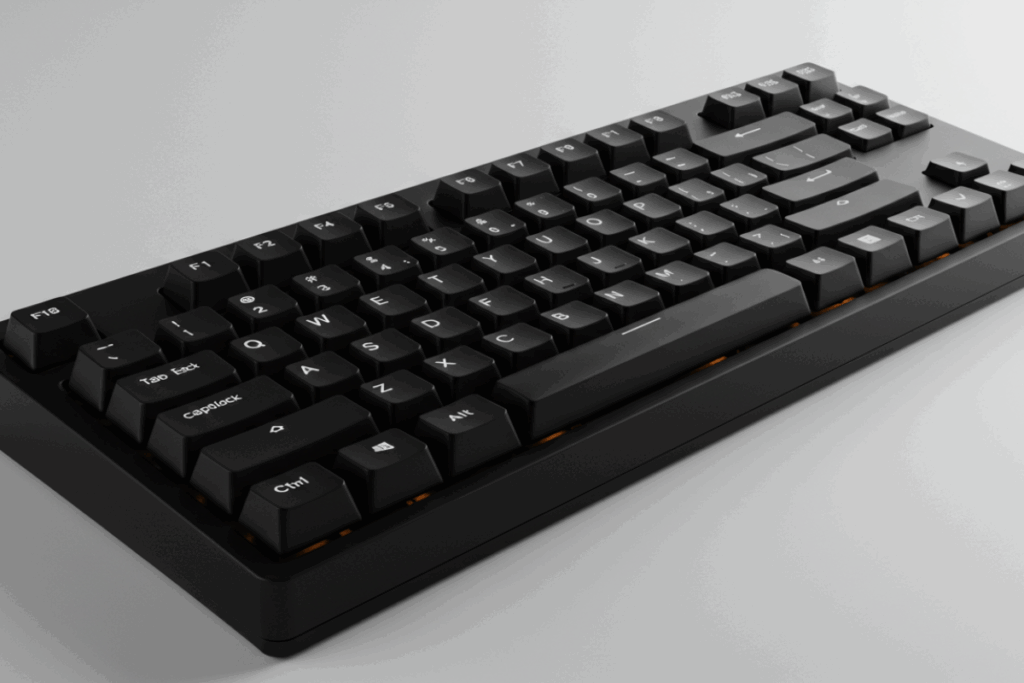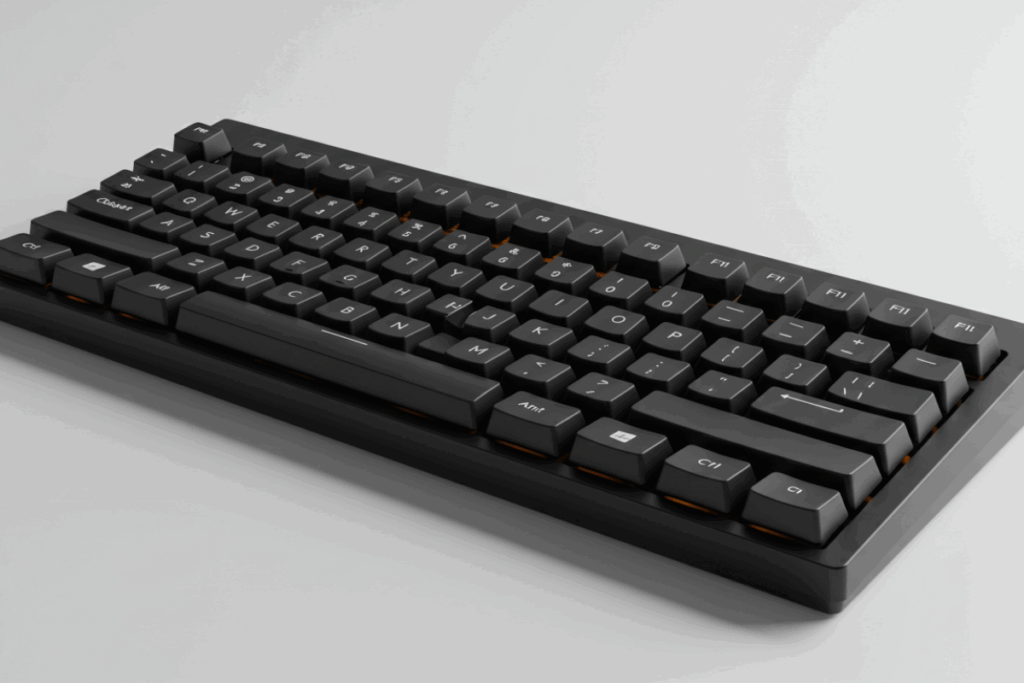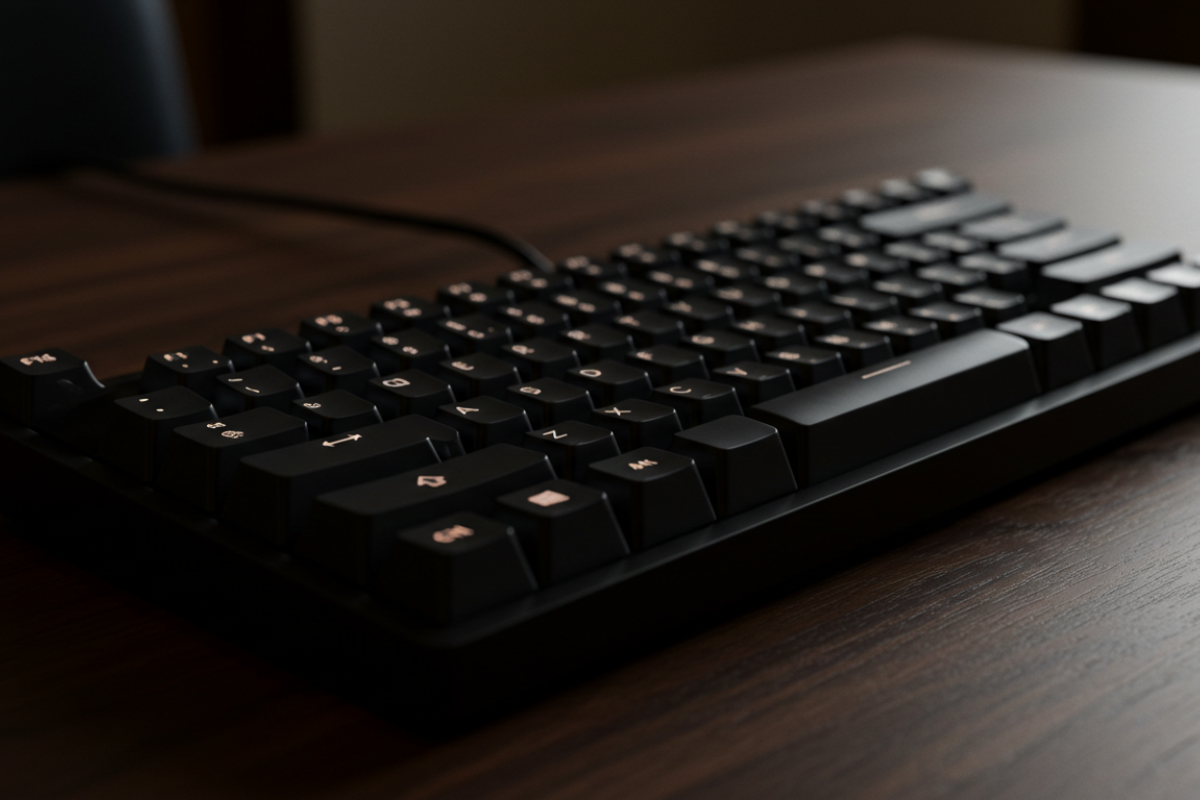keyboard size comparison is my cheat sheet when I hunt for the right keyboard. I care about how a board’s footprint and layout change my desk space and my flow. I test how full layouts and compact ones affect number entry and shortcuts.
I watch ergonomics, wrist angle, and reach. I check switches, hot-swap options, and keycap feel for upgrades. This short guide from Keyboards Technology shares what I learned and helps you pick the best size for work, gaming, travel, or comfort.
Key Takeaway
- I choose full‑size when I need a numpad for work.
- I pick TKL (tenkeyless) to free mouse space for gaming.
- I grab compact (60%/65%) models for travel and minimal desks.
- I test switches at Keyboards Technology to dial typing feel.
- Match keyboard size to the job — a quick keyboard size comparison saves returns.
Why I care about keyboard size: keyboard size comparison basics
I pick a keyboard for one reason: how it fits my life. My desk is small. My hands are fixed. A change in keyboard size can feel like moving furniture. I like Keyboards Technology because they make the choice clear.
How footprint and key count change my desk space
A bigger keyboard eats space; a smaller one frees it. I measure by footprint (physical size) and key count (how many keys). Both matter.
| Keyboard type | Key count (typ) | Approx width (cm) | Desk impact |
|---|---|---|---|
| Full-size | 104 | 44–46 cm | Uses most space; great for numpad tasks |
| Tenkeyless (TKL) | 87 | 36–38 cm | Frees mouse area; balanced |
| 75% | ~84 | 32–34 cm | Compact but keeps arrows and fn row |
| 65% | ~67 | 29–31 cm | Small; arrows present; needs layers |
| 60% | ~61 | 27–29 cm | Very small; heavy on layers |
I once squeezed a full-size on a tiny table; my mouse hovered above my cup. Switching to a TKL let my mouse glide naturally — big comfort gain.
How layout affects workflow and shortcut access
Layout shapes how I work. For spreadsheets and accounting, the numpad on a full-size is a workhorse. For coding or fast editing, a TKL gives mouse room while keeping main keys. For ultra-portable setups, 60% or 65% boards force layers and shortcuts.
How I think about layouts:
- Full-size: best for number-heavy jobs.
- TKL: best balance of desk space and keys.
- 60%/65%: best for minimalism and portability if you accept extra shortcuts.
I prefer TKL most days; it keeps shortcuts close and the mouse reachable. If I need fast number entry, I add a numpad or switch to full-size from Keyboards Technology.
Common sizes explained: full-size vs tenkeyless to 60% vs 65%
A clear keyboard size comparison saved me hours of trial and error. Below I walk through what each layout gives and what you give up.
What a full-size and 96% board give
A full-size board gives a numpad, full navigation cluster, and all function keys. I use it for spreadsheets and finance work — it stops finger gymnastics.
A 96% board squeezes the same keys into a tighter package: numpad and arrows, but narrower. Good compromise when you want full function with less desk clutter.
- I prefer full-size for heavy data entry.
- I like 96% on a smaller desk without losing keys.
| Layout | Approx keys | What I get | Trade-off |
|---|---|---|---|
| Full-size | ~104 | Numpad, nav cluster, function row | Bigger footprint |
| 96% | ~96 | Numpad arrows in tighter layout | Slightly cramped spacing |
What 75%, 65%, 60% and 40% boards trade off
Compact boards trade keys for portability.
- 75%: Keeps function row and arrows; compact block.
- 65%: Drops function row but keeps arrow keys and a small nav cluster. Good for coding and daily typing.
- 60%: Drops arrows and nav keys; rely on layers. Great for cafes and travel.
- 40%: Bare-minimum; only letters and modifiers — steep learning curve.
| Layout | Approx keys | What I get | What I trade |
|---|---|---|---|
| 75% | ~84 | Compact arrows fn row | Narrower spacing |
| 65% | ~67 | Arrows some nav keys | No function row; needs layers |
| 60% | ~61 | Very compact; portable | No arrows/nav; heavy layer use |
| 40% | ~40 | Tiny footprint | Many keys removed; steep learning |
I switched from full-size to 65% once. My desk looked cleaner and my hands traveled less; I typed faster within a week — worth the trade.
Fact: 60% vs 65% differences in arrow and nav keys
- 65%: arrows present — easier navigation.
- 60%: arrows via layers — smaller and lighter.
I pick 65% when I want compact size but still want dedicated navigation. 60% when travel weight and minimalism matter most.
Who I recommend each size to — pick your perfect keyboard by use
Office and data work: why I choose full-size or 96%
For spreadsheets and quick numeric entry I reach for full-size or 96%. The numpad saves seconds that add up across a day.
| Size | Keys kept | Desk space | Best for |
|---|---|---|---|
| Full-size | All keys numpad | More space | Heavy data entry, accounting |
| 96% | All keys compressed | Medium | Office work, smaller desks |
Keyboards Technology makes solid full-size and 96% models I trust for long typing sessions.

Gamers, programmers, and travelers: when I pick TKL or 60/65
For gaming I often pick TKL. Losing the numpad frees space for the mouse, giving more arm room and faster moves.
For travel or tiny desks I choose 60% or 65%. They pack in bags and stay light. For programming, TKL is great for shortcut-heavy work; 65% helps when I travel but still want arrow keys.
| Size | Portability | Shortcut access | Best for |
|---|---|---|---|
| TKL | Medium | High | Gamers, programmers at desk |
| 65% | High | Medium | Travelers, programmers who like arrows |
| 60% | Very high | Low (layers) | Compact travel, minimalists |
I use Keyboards Technology compact boards on trips — sturdy with consistent key feel.
Quick rule: pick by numpad needs
- Use numbers constantly → full-size/96%.
- Want mouse space but most keys → TKL.
- Travel or max desk space → 65%/60%.
One question I ask: Do I touch the numpad every day?
- Yes → Full-size/96%.
- No → TKL/65%/60%.
A quick keyboard size comparison of footprint and layout before buying saves returns.
Ergonomics and typing comfort: ergonomic keyboard size guide
I test for wrist angle, reach, and posture. Small swaps can cut pain and boost speed.
How size affects wrist angle, reach, and posture
Size changes how hands sit. A big keyboard pushes shoulders and stretches wrists; a compact one brings hands together and shortens reach. I switched from full-size to 65% after wrist tightness — it eased in a week.
| Size | Approx width (cm) | Wrist angle effect | Reach & posture |
|---|---|---|---|
| Full-size (100%) | 45–50 | Neutral to extended if mouse far | Longer reach; shoulders wider |
| TKL | 35–40 | Better wrist alignment | Mouse closer; less shoulder strain |
| 75% | 30–34 | More compact wrist position | Shorter horizontal reach |
| 65% | 28–31 | Keeps wrists more neutral | Less shoulder rotation |
| 60% | 25–28 | Can force tighter wrist bend for some | Very short reach; may remap keys |
If my forearm-to-palm angle tilts too much, I change size or height. If the mouse is out of reach, I get shoulder pain fast.
Split and tenting options I use to reduce strain
I prefer split keyboards for long typing sessions. Splits let me place each half under my shoulders and reduce rotation. Tenting (5–10°) reduces ulnar deviation; small front tilt matches hand slope.
Practical moves:
- Place halves at shoulder width so elbows relax.
- Try 5° tent first; keep if pain drops.
- Use a palm rest only if it keeps wrists straight.
- Test sizes before buying (e.g., 65% split vs 75% split).
I trust Keyboards Technology for builds that let me tweak split and tent settings easily.
Tip: the best size for typing depends on reach and breaks. If you reach for the mouse, go smaller or bring the mouse closer. If wrists tilt up, raise the board or tent. Take a 5-minute stretch every hour.
Technical specs and customization to compare in a keyboard size comparison
Switch types, hot-swap vs soldered, and keycap profiles I check
Start with switches: linear, tactile, or clicky. Check actuation force, travel, and sound. Stem type (Cherry-style vs others) affects compatibility.
I prefer hot-swap when I want to try switches fast — pull and drop in a new switch. Soldered boards can feel more solid but require desoldering to change. Keycap profile and material matter: Cherry, OEM, SA, DSA; PBT vs ABS. Thick PBT sounds deeper and lasts longer.
| Feature | What I look for | Why it matters |
|---|---|---|
| Switch type | Linear / Tactile / Clicky | Typing feel and noise |
| Actuation force | 40–70g typical | Effort per key |
| Hot-swap | Yes / No | Swap switches without soldering |
| Keycap profile | Cherry / OEM / SA / DSA | Finger travel and comfort |
| Keycap material | PBT / ABS | Durability and sound |
Connectivity, battery life, weight, and materials by size
Smaller boards favor wireless and low weight; bigger boards favor wired and heavier cases. Test real battery life: many wireless 60% boards run 30–80 hours with backlight off. Full-size wireless boards often have larger batteries.
Weight influences stability. Heavy boards stay put; light boards move. Materials matter: plastic is light; aluminum or steel gives density. Plate materials (brass, aluminum, polycarbonate) change sound and feedback.
| Size | Typical connectivity | Typical battery life (wireless) | Typical weight | Common materials |
|---|---|---|---|---|
| Full-size | Wired / RF / BT | 40–120 hrs | 1.2–1.8 kg | Aluminum, plastic |
| TKL | Wired / BT | 30–100 hrs | 0.9–1.4 kg | Aluminum, plastic |
| 75% / 65% | Wired / BT | 20–80 hrs | 0.7–1.1 kg | Plastic, aluminum top |
| 60% | Wired / BT | 20–80 hrs | 0.5–0.9 kg | Plastic, sometimes aluminum |
Check firmware: on-board macros, layers, and lighting matter. I like boards programmable without third-party apps. At Keyboards Technology, I test firmware and call out what works.
Compare: hot-swap boards and upgradeability across sizes
Hot-swap keeps a board current, but upgrade paths vary. Full-size and TKL often have more hot-swap PCBs and plate support. 60% can be hot-swap, but layout mods are trickier.
| Size | Hot-swap availability | Upgrade notes |
|---|---|---|
| Full-size | High | Many PCBs and plate types; easy stabilizer swaps |
| TKL | High | Good for mods and switch tests |
| 75% / 65% | Medium | Many hot-swap models; check layout support |
| 60% | Medium/Low | Good for switches; harder for layout mods |
Always check stabilizer and plate fit before buying — some hot-swap sockets sit close to the plate and can block certain switch housings.
My buying checklist and quick quiz to choose keyboard layout size
Eight simple questions I ask: numpad, travel, macros, wireless
Ask yourself blunt questions:
- Do I use a numpad daily?
- Will I travel with the keyboard?
- How much key travel do I want (short vs long)?
- Do I need programmable macros?
- Do I want wireless?
- How tight is my desk space? (measure — leave an inch for the mouse)
- What’s my main use: typing, gaming, or both?
- Standard layout or custom keys?
Quick quiz: give 1 point for each yes to numpad, big travel, macros, wired, full desk, heavy typist, standard layout, no travel.
- 6–8: Go full-size.
- 3–5: Try TKL.
- 0–2: Pick compact (60%/65%).
I used this test to avoid a flashy compact that slowed my accounting work — match the keyboard to the job.
Pros and cons by size: compact vs full size at a glance
A short keyboard size comparison I use when torn:
| Feature | Compact (60–75%) | Full size (100%) |
|---|---|---|
| Keys | ~61–84 | ~104 |
| Width (approx.) | 11–14 in | 17–18 in |
| Numpad | Usually no | Yes |
| Desk space | Saves space | Needs more room |
| Portability | Easy to carry | Bulky |
| Custom keys/macros | Often needs layers | Easier to include |
| Typing comfort | Can be cramped | Classic layout |
| Gaming | Great for small setups | Good, but large |
Compact = portable, clean desk, faster hand travel. Con: missing numpad and some keys.
Full size = complete layout, excellent for typing and numbers. Con: takes desk space.

Quick decision flow: how to pick keyboard size in five steps
- Measure your desk. If under 24″ usable width, go compact.
- Do you use the numpad daily? If yes, pick full size.
- Decide on portability. Travel often? Choose compact and wireless.
- Check your workflow. If you use macros or extra keys, prefer TKL or full.
- Try before you buy if possible — otherwise pick from Keyboards Technology (their return policy helped me).
Conclusion
Pick a keyboard that fits your life, not just your desk. If you crunch numbers, go full-size or 96% for the numpad. If you want a cleaner desk and better mouse room, reach for TKL.
If you travel or crave minimalism, 60%/65% wins for portability, but expect a short learning curve with layers. Always check ergonomics first: wrist angle, reach, and whether split or tent helps your shoulders. Test switches and prefer hot-swap when you plan to tweak feel later.
Think of it as moving furniture: a size change can make the whole room feel different. Try before you buy, run the quick quiz (do I use the numpad daily?), and remember that build, battery, and firmware matter as much as layout. A final quick keyboard size comparison of footprint, keys, and ergonomics will save you time and returns
Frequently asked questions
Q: How do I choose in a keyboard size comparison?
A: Start with what you do most. Gaming → TKL or 60/65. Number entry → full-size. Use my quick quiz to decide.
Q: What’s the difference between full-size and TKL?
A: Full-size has a numpad and full keys. TKL drops the numpad to save desk space and give more mouse room.
Q: Are 60% keyboards good for gaming and travel?
A: Yes. They’re tiny and light. Some keys are on layers, so you’ll learn shortcuts. I trust Keyboards Technology‘s portable models.
Q: Will compact keyboards slow my typing?
A: Not long. You adjust in a few sessions. Layers add initial friction, but smaller hand travel often speeds you up.
Q: How do I balance ergonomics with portability?
A: Choose split or TKL for comfort; 60% for travel with a detachable cable. Smaller boards reduce reach and often improve wrist alignment. Test ergonomics before buying.
Final tip: run a quick, practical keyboard size comparison on paper — trace the footprint, place your mouse, and see how your shoulders and wrists feel. It’s the fastest way to avoid surprises.

